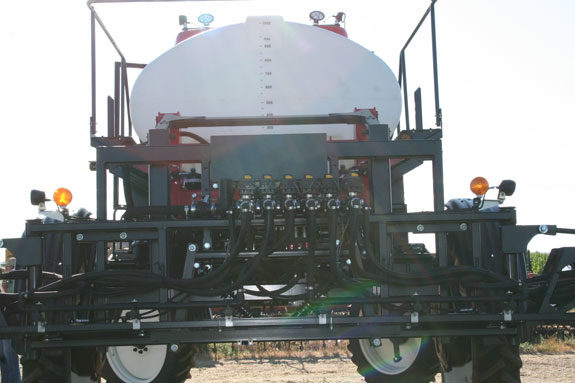Prior to storing a sprayer for the winter it needs to be thoroughly rinsed of all pesticide residues. It is better to rinse the sprayer several times with a small amount of clean water than to fill it up only once.
Dispose of the rinsate in a field that has proper setbacks from all water sources. Do not allow the rinsate to accumulate into puddles.
It is preferable to rinse the sprayer on an impervious surface where the rinsate can be collected and taken to a Clean Sweep site.
At this time make sure that all water is drained out of the sprayer so no damage is caused by water freezing. Once the inside of the tank is cleaned out do not forget about the outside of the sprayer.
The outside should be rinsed with clean water and if at all possible on an impervious surface and the rinsate collected. Always remember to read the label of the pesticide used and use appropriate personal protective equipment when cleaning.
Cleaning
Once you have the tank properly rinsed the next step is to decontaminate it. You can purchase commercial cleaning agents or you can clean your system with some common household products.
Remember to run the cleaning solution through the entire system including agitation and return lines. Rinse clean water through the system after it has been thoroughly cleaned opening up the nozzles and running the water until only clean water is coming out.
Maintenance
Now that your sprayer is rinsed and cleaned, carefully inspect the system making note of any maintenance concerns and repairing them. Look at nozzles, screens, hoses, valves, pumps, boom, as well as the tank. Now is a good time to check for tank integrity.
Now is also the time to make any modifications that you need to make. Please remember that even though the system has been cleaned you still need to be cautious and wear all labeled personal protective equipment.
Storage
The final step is to properly store the system. Any removable parts should be removed to ensure that there is no damage during storage. For example nozzles, filters, tips, check valves, screens, pressure gauges. If at all possible store these in an area that will not freeze.
Clean filters with soapy water before storage. The last step is to circulate antifreeze throughout the system including the boom’s hoses. Cap the boom nozzles, one or two nozzles may need to be left open to ensure total circulation remember to cap them when the system is filled, to make sure that antifreeze is in the entire system.
Your system is now ready for storage. If you have foam markers and flowmeters don’t forget to clean these also. To clean them follow the manufacturers' suggestions. FG
Christina Curell
Michigan State University Extension
curellc@msu.edu
—Michigan State University Extension News for Agriculture, http://news.msue.msu.edu
PHOTO
FG Staff photo.









